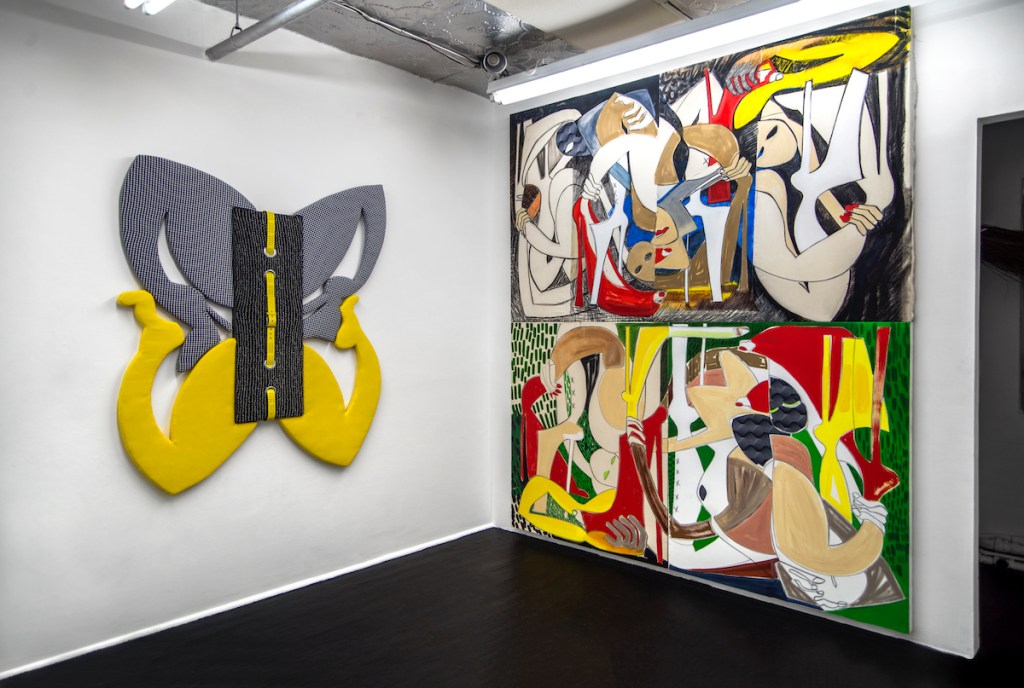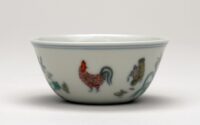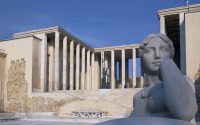The Best Booths at Art Basel Miami Beach, From Female-Gazed Men to Painstaking Assemblages
A week and a day later than usual, Art Basel Miami Beach, now on its 21st edition, has finally touched down at the Miami Beach Convention Center. Just before its 11 a.m. opening, a seemingly endless line had already wound its way through the center’s Washington Avenue entrance. Inside, the energy was strong, even if the aisles seemed slightly thinner this year. Several blue-chip dealers did report sales by the early evening, though that is a far cry from the first-hour sales that were commonplace only a few years ago.
“The fair feels sluggish, to me, and not as convivial as years past. Collectors don’t seem to have the same urgency and competitive spirit that has made the first day feel like a running of the bulls,” New York–based adviser Alex Glauber told ARTnews.
Since late summer, there has been much talk about whether or not the market is softening. That clamor has only increased since the Hamas attack of October 7 and Israel’s subsequent airstrikes on Gaza. Are sales really that depressed? Dealers queried about this Art Basel Miami Beach seemed split, with some agreeing that the market had weakened and others saying that their sales had picked back up. Most expressed a cautious sense of optimism about what’s to come.
What was clear was that the fair was physically different than it was before. Its floor plan has shifted—a welcome change after last year’s much more chaotic arrangement. While the fair might be a bit harder to navigate the aisles vertically (east to west, per the map), a methodical approach can be had with by tackling the aisles horizontally (north to south, beginning from the Meridians section). Plus, there are now mini cafes that dot the fair; these had shorter lines that took only 10 minutes to get food, as opposed to the usual 45-minute-plus waits that often accompany food options on opening day.
Art-wise, the pickings are rather safe this year—which is typically the case in a soft market, as galleries look to balance their books come December 31. But you will find gems among the 175 booths no less.
Below, a look at the best booths on view at Art Basel Miami Beach, which runs until Sunday, December 10.
-
Shizu Saldamando at Charlie James Gallery

Image Credit: Maximilíano Durón/ARTnews Shizu Saldamando, a standout of the fair’s Nova section for works created in the last three years, paints her portraits on wood panels, whose grain she ends up incorporating into her compositions. To these, the artist adds pieces of washi paper, glitter, and even vintage glass—though these elements typically during close viewing.
Saldamando’s tender portraits depict members of her circle, including performance artists Pony Lee and Young Joon Kwak, model Mercy Rivera, and activist and health organizer Angel Martinez. But the highlight here depicts the iconic Chicana artist Yreina D. Cervantez, who has influenced generations after her. Saldamando first met her years ago at Self-Help Graphics, the hallowed Los Angeles arts center that has been central for many Chicanx artists.
Her booth also includes sculptures, which Saldamondo began producing during lockdown. As with her use of washi paper, these works reference her Japanese heritage, specifically her maternal family’s experiences in internment camps during World War II. There, flowers were made from paper, and art was often crafted from the scraps of what could be found. Wall-hung works are set on a metal grid that recalls the fences that would have enclosed her ancestors.
-
“Brockman Days: 1967–1990” at Parrasch Heijnen and Franklin Parrasch

Image Credit: Maximilíano Durón/ARTnews One wall of this booth is dedicated to the important work of the Brockman Gallery, the first Black-owned, artist-run space in Los Angeles. Founded by brothers Alonzo Davis and Dale Brockman Davis in 1967 and located in the historically Black neighborhood of Leimert Park, the gallery was instrumental in giving early support to Black and Latinx artists at a time when they would likely be ignored by white-owned galleries. Among the artists included in the booth are Romare Bearden, David Hammons, Suzanne Jackson, Maren Hassinger, Noah Purifoy, Mildred Howard, Samella Lewis, Frank Romero, Linda Vallejo, and Charles White, the brothers’ one-time professor at Otis College.
-
Vivian Browne at Ryan Lee Gallery

Image Credit: Maximilíano Durón/ARTnews This booth, located in the Survey section for art historically minded presentations, is devoted to the under-recognized artist Vivian Browne. While her work from the 1960s is marked by semi-figurative, her works from the early 1970s, shown here, are much more abstract. They were made after a career-altering trip to Africa in 1971, where she was blown away by the colors and patterns she saw in the country—and also overwhelmed by them. When she returned to New York, she got to work, translating what she saw and felt into exquisite abstractions that still radiate some 50 years later. (Several works from this era were the subject of an exhibition at the SoHo loft of jazz musician Ornette Coleman in 1974.) Browne will be the subject of a traveling survey beginning in 2025—I cannot wait for it.
-
Kang Seung Lee at Commonwealth & Council

Image Credit: Maximilíano Durón/ARTnews Part of a three-person booth that also includes stunning pieces by rafa esparza and Guadalupe Rosales, this sculpture by Kang Seung Lee, a participant in the Hammer Museum’s Made in LA biennial, resembles a black T-shirt and reads “SLUTFORART.” Lee’s practice revolves around honoring his queer ancestors, in particular those who have been lost to AIDS. “SlutForArt” was the motto of late photographer Tseng Kwong Chi, which he would wear on badges. Nearby, using graphite, Lee has meticulously re-created the photographer’s pictures of himself in his Mao suit before landmarks like the leaning Tower of Pisa, the Colosseum, and the Christ the Redeemer statue in Rio de Janeiro. Where as the photographs are crystal clear, Lee’s representations of the artist are blurred—a haunting reminder that Kwong Chi has slipped away from us, even if his works remain.
-
Pepe Mar at David Castillo Gallery

Image Credit: Maximilíano Durón/ARTnews For this assemblage, Miami-based artist Pepe Mar sourced his objects from LGBTQ thrift stores that the artist visits multiple times a week. Assemblages like this one often take months to complete, as Mar is exacting as locates material for his assemblages. In this insect-like sculpture are buckets, vases, animal figures, wood, and more, all encased behind a yellow-green Plexiglas box. In the lower section, there is what at first glance appears to be affixed powder pigment. It is, in fact, a swath of fabric that Mar applied and then tore off. In Mar’s hands, the past lives of this ghostly fabric become visible.
-
Azza El Siddique at Bradley Ertaskiran

Image Credit: Maximlíano Durón/ARTnews A slow process of destruction is currently taking place in the booth of Montreal-based gallery Bradley Ertaskiran, courtesy of New Haven–based artist Azza El Siddique. In the center of the booth, a metal structure slowly drips water onto a suite of half-fired and misfired clay pots. Just an hour into the fair’s opening, some of them were already beginning to wear away from the water; they will likely be mere puddles come Sunday. In the center of the structure is an LED display showing excerpts from the Book of Dead, which is depicted like a stock ticker. At front are two cement sculptures of her Doberman, rendered like sphinxes. In pairing ancient Egyptian funerary practices with modern-day symbols of power and wealth and the eventual decay of the clay pots, El Siddique has created a poignant installation.
-
Devin N. Morris at Deli Gallery

Image Credit: Maximilíano Durón/ARTnews Having recently completed the storied artist residency at the Studio Museum in Harlem, Devin N. Morris is showing a recent suite of sculptures with Deli Gallery. All of the components for these works were found across New York City, in locales ranging from Harlem to the Bronx to Brooklyn. Morris then repurposes these discarded objects, breathing new life into them as artworks in which the artist depicts scenes of Black American domesticity.
-
Pedro Figari at Galeria Sur

Image Credit: Maximilíano Durón/ARTnews Pedro Figari, one of Uruguay’s most important modern artists, is primed to receive greater exposure and importance outside his home country and Latin America more broadly. (He was the subject of major survey at the Museu de Arte de São Paulo in 2018.) Born in 1861, Figari came to painting late in life, after a successful career as a lawyer and then as a senator in Uruguay’s parliament. On view here are works made in the early 1930s, just a few years before his death in 1938. His imagined scenes depict the interior lives of Uruguay’s Black communities, whose joy and moments of celebration he was dedicated to representing. Figari, who was white, was keenly aware that these were often not highlighted within the Uruguayan popular imagination, and he sought to remedy that.
-
David Almeida and Fran Chang at Millan

Image Credit: Maximilíano Durón/ARTnews São Paulo’s Millan has become known in recent years for spotting emerging talent in Brazil, and the Art Basel Miami Beach booth suggests that the gallery remains particularly perceptive in that regard. While a large-scale Maxwell Alexandre work from 2021 dominates the booth’s entrance, it is the small-scale works in the back that are most worth checking out. There are two distinct approaches to paintings by artists David Almeida, who carves into his wood panels before creating his expressionistic lush landscapes, and Fran Chang, who produces precise scenes of the beach that are done on silk.
-
Caroline Coon at Stephen Friedman Gallery

Image Credit: Maximilíano Durón/ARTnews London-based artist Caroline Coon, now in her late 70s, has long made feminist-minded paintings. But she differs in one key respect from some of her contemporaries in that instead of trying to reclaim women’s bodies from the male gaze, she applies the female gaze to the male body. Depicting these men stark naked with bulging muscles, plump asses, and large penises, they are the objects of her desire. A highlight of this Kabinett presentation, which the gallery will rotate over the course of the fair, is 1999’s Adonis Beach showing five naked men in the foreground, surfboards in hand, while a dozen or so (also naked) are out catching some waves.


